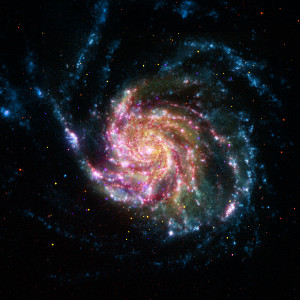LENS Engineering, Science, and Technology
Dark Matters
New Findings Challenge Fundamental Theory
 IMAGE: NASA/JPL-CALTECH/ESA/STSCI/CXC
IMAGE: NASA/JPL-CALTECH/ESA/STSCI/CXCFew scientists discover a new law of nature or change our understanding of how the universe works.
But Stacy McGaugh, PhD, a professor and chair of Case Western Reserve’s Department of Astronomy, and Federico Lelli, PhD, who worked on the research as a postdoctoral scholar at the university, may have done both.
In a recent study, the two identified a new law of nature that describes the behavior of galaxies. This law undermines the case for the existence of dark matter, which has been central to explanations of the origin and development of the universe since the 1970s. That’s when astronomers noticed that stars orbited some galaxies more slowly than they would expect, given the law of gravity and the visible masses of the galaxies themselves. To account for this anomaly, scientists postulated the existence of extra mass they couldn’t see: dark matter.

Stacy McGaugh, professor
Using ultra-sensitive infrared measurements, McGaugh and Lelli demonstrated that the orbital velocities of stars in galaxies of all kinds can be predicted from the visible mass alone.
And that deals a “serious, and potentially fatal,” blow to the dark-matter hypothesis, said David Merritt, PhD, a professor of physics and astronomy at Rochester Institute of Technology, who was not involved in the research.

Federico Lelli, astrophysicist
McGaugh’s and Lelli’s discovery either means that dark matter behaves in a way that physicists don’t yet understand, or that the theory of gravity that led scientists to infer the existence of dark matter in the first place was flawed somehow.
McGaugh, who leans toward the second possibility, said more work is needed to determine which scenario is correct. But either way, he said, “much of what we thought we knew about cosmology may be wrong.”





